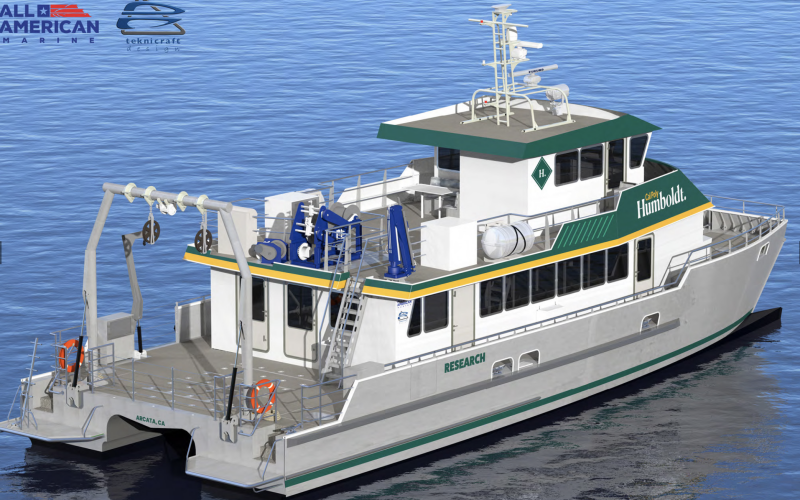All American Marine, Bellingham, Wash., will build a research vessel for the California Polytechnical Institute at Humboldt, building on the company’s recent success with similar designs for near-coastal science work.
The Cal Poly vessel will be a 78’ x 26.7’ semi-displacement aluminum catamaran developed by Nic de Waal of Teknicraft Design, Auckland, New Zealand. It will incorporate proven design elements of two research vessels recently delivered by AAM: the R/V Shackleford for Geodynamics, Newport, N.C., which was named a 2023 WorkBoat Significant Boat of the Year, and University of Hawaii at Manoa’s R/V Imua.
Cal Poly's vessel will be inspected to US Coast Guard (USCG) Subchapter T standards and operate as a multipurpose research vessel in the near-coastal waters of northern California and Oregon and on offshore and ocean routes.
Twin-engine speed and fuel efficiency ae important for Cal Poly’s research needs in their Northern California location, with immediate access to coastal environments and deep-water environments of continental shelves, slopes, and canyons. Similar to the R/V Shackleford, the vessel for Cal Poly will be capable of supporting the emergent offshore wind industry on the West Coast. It will be outfitted with a Kongsberg ADCP electronics suite augmented by a fixed WASSP multibeam system.
“The vessel integrates the signature Teknicraft Design symmetrical and asymmetrical combined hull shape, bow wave piercer, and a patented dynamic hydrofoil-assisted hull design,” according to a statement from AAM. “The hull and hull components are designed to break up wave action and ensure reduced drag while enhancing passenger comfort. This design is proven to have both low-wake wash energy and increased fuel economy. This advanced hull shape was custom-designed using digital modeling and computational fluid dynamics analysis testing.”
AAM says the Teknicraft designs feature excellent fuel economy, consuming around the same gallons per nautical mile throughout the estimated cruising speed of 18-24 knots, with a fuel-efficient survey operation speed of 4-8 knots, fully laden. With a fuel capacity of 1,600 gallons, the vessel will carry will up to 40 total day passengers, or 14 live-aboard.

The propulsion package includes two fixed-pitch propellers powered by twin MAN D2862LE438 EPA Tier 4 engines equipped with a diesel particulate filter. The engines, rated at 1,182 bhp at 2,100 RPM, are designed to meet California air emission requirements.
Onboard the vessel, scientists and crew will have comfortable live-aboard quarters, large wet and dry lab spaces, as well as a range of oceanographic equipment for a variety of missions.
“From the outset, our discussions with All American Marine have been highly productive in designing a vessel that is being built specifically to advance our academic vision of educating future scientists, while keeping the latest environmental standards in mind,” said Eric Riggs, Dean of Cal Poly Humboldt’s College of Natural Resources & Sciences.
Riggs said All American Marine’s earlier research vessel newbuilds influenced the decision Cal Poly officials’ decision to go with AAM.
“They have an excellent record designing and building state-of-the-art research vessels to the performance specifications we need on California’s North Coast, and this was a key consideration when we chose them as our builder. Upon completion, this vessel will become the centerpiece of our academic fleet, supporting our marine research and teaching efforts for decades to come.”
All American Marine president and COO Ron Wille said his company “remains on the leading edge of manufacturing techniques and is an industry innovator, merging the latest technology into a functional and proven vessel.”
“We are thrilled to receive this contract for another multi-mission research vessel that will service a variety of critical missions such as offshore research, oceanographic surveys, and ocean monitoring, as well as informing the emergent offshore wind market on the West Coast. This vessel will open a new era of ocean conservation and research capabilities.”





